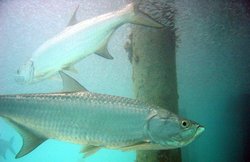Tarpon
|
|
| Tarpons | ||||||||||||
|---|---|---|---|---|---|---|---|---|---|---|---|---|
| | ||||||||||||
| Scientific classification | ||||||||||||
| ||||||||||||
| Species | ||||||||||||
|
Megalops atlanticus |
The tarpons are large coastal fish notable as a prize of anglers. There are two species in a single genus Megalops in the family Megalopidae, one native to the Atlantic, and the other to the Indo-Pacific area.
The (Atlantic) tarpon, Megalops atlanticus Valenciennes 1847, inhabits coastal waters, estuaries, lagoons, and rivers. It feeds on various fish and crabs. It is capable of filling its swim bladder with air and absorbing oxygen from it. Specimens have been recorded at up to 250 cm in length and weighing up to 161 kg.
In appearance, it is greenish or bluish on top, and silver on the sides. The large mouth is turned upwards, the lower jaw containing an elongated bony plate. The last ray of the dorsal fin is much longer than the others, reaching nearly to the tail.
The tarpon is considered one of the great saltwater game fish, not only because of the size it can reach and its accessible haunts, but because of its fighting spirit when hooked; it is very strong, making spectacular leaps into the air. The flesh is desirable but bony. In Florida, a special permit is required to kill and keep a tarpon, so most tarpon fishing there is catch-and-release.
The Indo-Pacific tarpon, Megalops cyprinoides is a less-known and smaller fish.
External links
- Fishbase info for Megalopidae (http://www.fishbase.org/Summary/FamilySummary.cfm?ID=47)
- Field & Stream on tarpons (http://www.fieldandstream.com/fieldstream/fishing/saltwater/article/0,13199,232866,00.html)

